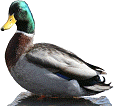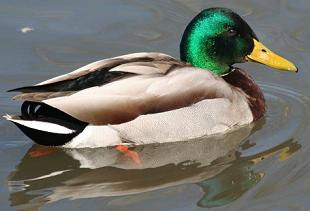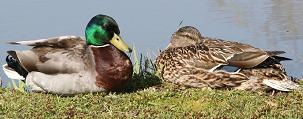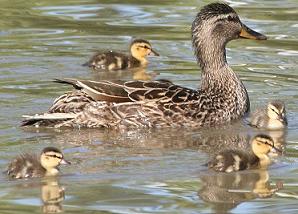Mallard Duck 
Identification - Pictures and Video
(Anas platyrhynchos)
Mallard Ducks are probably the best-known of
all ducks. In fact they are the ancestor of almost all of
our domestic ducks. They grow 18 to 27 inches in length.
They are identified by most people by the male or drake's iridescent
green head and narrow white collar. Their body is
grayish with chestnut breast, and white tail feathers with
black central tail feathers that curl up. They have a
yellow bill and orange feet and a purple speculum. Unfortunately
like most birds he will loose his bright colors after breeding
season.
Photos by Keith
Lee. The camera I use is the Canon
EOS 40D. Visit All-birds store

The females are mottled brown with a white
tail, and a mottled brown and orange bill. Juveniles are
similar to females. Mallards are often seen in small
flocks flying in a V formation.

View
video of mallard duckling in small stream.
For
other bird videos please visit our Youtube channel and
subscribe or like our videos.
Most videos on my site were taken with the Canon
HG10 camcorder.
Duck sound
Ducks are noisy birds. Males call
is a low nasal quack. During mating season they make
sharp whistles. Females voice is
quack-quack-quack. Sound
Preferred Habitat
Mallard is found throughout North America.
They prefer calm shallow water, but can be found in almost any
body of water from marshes, ponds, rivers, lakes, and irrigated
land. They are often seen in city parks.
Breeding and Nesting
Mallard breeding season starts in the fall, and
they will pair up by winter. During courtship the male
will whistle, and grunt, pump his head, and preen in front of
the female. Females will respond with loud calls, and
posturing. This normally takes place in the water.
They will also do chase flights. Once paired if they
migrate they will migrate to the females territory of origin.
Attended by the male the female will choose a
nesting site. They normally nest in the reeds. The
female builds a hollow nest with grass, leaves and feathers,
lined with down. Occasionally they may use the nest of
other birds such as a crow or hawk. Females lay and
incubate 8 to 15 eggs for about a month. Mallard eggs
vary in color from creamy white, pale blue to blue-green and
they have no markings. While she is incubating the eggs
the male may leave and join a flock of other males.
Ducklings are born precocial. They can swim, and feed
themselves shortly after hatching. They will fledge in
around 8 weeks, but until then they will follow the mother for
protection. While the female is raising the young birds
the male will leave to molt. This takes 2 to 3 weeks, and
he will be temporarily flightless. When they are done
they will look much like the female.

Food
The mallards main diet is aquatic vegetation,
fish, and invertebrates which they get by dabbling near the
water surface. Often they can be seen complete upended
as they dip below the surface. They also eats grains and
plants on land.
To learn about other favorite
birds click here.

|
